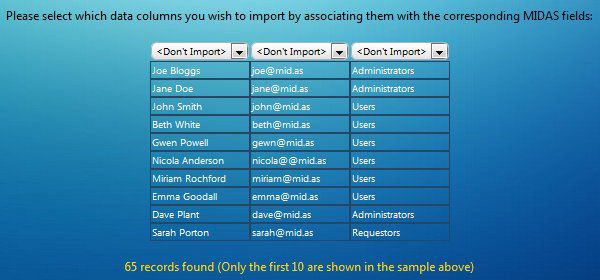
Can I bulk import users into MIDAS?
You can import users from other applications into MIDAS via MIDAS Admin Options → Import / Export. (In older versions of MIDAS, this could be found instead under Manage MIDAS → Database → Database Tools → Import Data)We strongly advise backing up your database before importing any data
Prerequisites
Using the import tool, you can import user data into MIDAS v4.06 or later, that is either in a .csv (Comma Separated Values), or .txt (Tab, or other character, Delimited) file format.Preparing your data for import
In order to import new accounts into MIDAS, your data for import needs to include the following distinct fields/columns as a minimum:- The user's full name
- The user's email address
- A password field / column (if you wish to specify initial passwords for the accounts you are importing)
- A user Group field / column (if you wish the imported account's permissions to be based on the permissions of an existing User Group in MIDAS)
Once you have your exported or manually created data prepared, you are ready to import your data into MIDAS.
You can import user data via MIDAS Admin Options → Import → Users.
Step 1 - Specify file to import

- Use the "Select File..." button to locate your .csv or .txt data file to import.
- If running multiple databases in your MIDAS booking system, select the database you wish to import user data into.
- If each field in your data file is "Comma Separated", select the "Comma" delimiter option.
- If each field is separated by a "Tab", select the "Tab" delimiter option.
- If each field in your data file is separated by a different character (i.e. the "|" (or "pipe") character), select the "Custom" option, and enter the delimiter character.
- If the first record (or "row") in your data file contains field names, rather than actual data select the "First row contains field names" option to prevent this data being imported into MIDAS.
- Click the "Next Step" button
Step 2 - Specify import options
The next screen will show you a "snapshot" of the data you are about to import in a table:
- At the top of each column in the table is a drop-down list allowing you to "assign" each column to a specific user field within MIDAS.
- For example, if the first column of your data file contains email addresses, select "Email" at the top of this column.
- Do this for all columns you wish to import.
- If your data contains columns, that you don't wish to import data from, select the <Don't Import> option from the drop-down at the top of these columns.
Please refer to the help documentation for detailed descriptions of the various account permissions available here.
In addition, if you are not importing passwords for your new accounts, you can tick the "Generate a random password for each user" option. When importing data, MIDAS will generate a random password for each new account imported. If you select this option, you should also consider selecting the "Auto send User their sign-in details via email". That way an automated email will be sent to each imported user notifying them of their initial sign-in credentials for the system.
Users will not be imported if the total number of existing user accounts plus new accounts being imported exceeds the maximum number of users your MIDAS system is currently licensed for. For example, if there are 10 existing accounts in your system, you wish to import 20 more, but your MIDAS is only licensed for a maximum of 20 users, only the first 10 from your data will be imported. If necessary, you can upgrade your MIDAS license to facilitate more users here
Step 3 - Import
Upon completion on the import (which may take several seconds depending upon the amount of data being imported), you should see the following confirmation. This will indicating how many new records have been imported:
← Return to the Knowledge Base